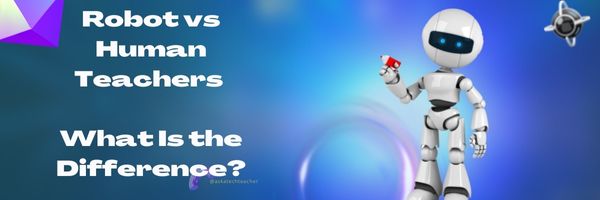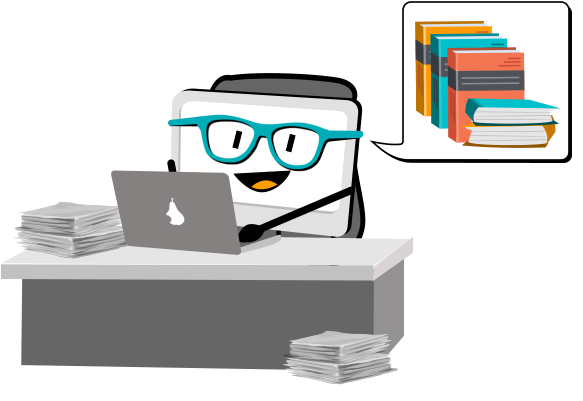Simona Johnes, editor-in-chief of Science and Literacy, an educational blog for teachers and parents, did some research into a topic that is of growing concern to my fellow teachers: Robots in the classrom. Here’s an interesting article comparing the pros and cons of robots vs. humans:
I recently came across an article published by Ohio State University that mentioned how several industries are using robots to get their jobs done, and the use of robotics is only expected to grow. This led me to thinking about the industry that I am currently employed in, education, and how this may affect my fellow teachers around the world. I began researching the topic and found a few articles about robots and artificial intelligence replacing teachers soon.
It was no surprise to see that educators are furious at this idea, and while I agree that human connection is important, I do think that there are several pros to having help from a robot in this tough industry from time to time. For example, robots can create a learning experience based on the personality of every single student, and this does not take much time or effort. I will explain more about what robots can help with throughout the article as well as explain why human teachers are still a necessity
After reading this article, you will officially know:
- 6 advantages of a human teacher
- 5 pros of a robot teacher
- Who is better Human of Robot teachers?
6 Main Advantages of a Human Teacher
 While the development of technology is constantly increasing and has transformed the education industry in ways, we never thought possible, experts still say that the possibility of teachers being replaced by robots remains low. The reason for this is because human teachers bring essential components to the classroom that robot teachers simply cannot do. I will tell you about the pros of a human teacher below.
While the development of technology is constantly increasing and has transformed the education industry in ways, we never thought possible, experts still say that the possibility of teachers being replaced by robots remains low. The reason for this is because human teachers bring essential components to the classroom that robot teachers simply cannot do. I will tell you about the pros of a human teacher below.
Here are a few of the pros of a human teacher:
- Human teachers have the ability to read social cues
- Human teachers can inspire children
- Human teachers have strong sensory feelings and emotions
- Human teachers can be creative
- Human teachers are social
- Human teachers do not have technical disruptions
Even though the use of technology continues to be on the rise, young people still need human teachers to help them remain in the reality in front of them. Young people are being pulled into a virtual world, but human teachers are able to show them how to socialize, be creative, have feelings and emotions, and more.
It is important to also mention that robot teachers are less likely to be able to maintain discipline and order in schools. Children may not take robots seriously and create total chaos if no human is in sight. Human teachers understand how to establish authority and remain strict with their students to ensure that their classroom remains in order. If you do not do so, your students will walk over you. To get some help with learning how to be strict with your students, check out my other article by clicking here.
5 Pros of a Robot Teacher
So many teachers are experiencing burnout, and they are leaving their positions to find better paying jobs that are not mentally exhausting. This has left school systems scrambling to fill those positions to educate students around the globe. Therefore, it is not shocking to learn that people are searching for ways to alleviate the pressure from teachers, which is where robotics has come into the conversation.
In China, a small robot named KeeKo is being used to help kindergarten teachers when needed. This little robot tells stories to the children, gives the students logic problems to answer, and shows certain facial expressions if the student gets the problem correct or wrong. KeeKo gives the human teacher a break for a few minutes to take a breather, focus on grading papers, or determine what the students will do next.
I recommend watching the video below to see KeeKo in action in a classroom. It looks like KeeKo is able to assist the teacher in the classroom, and the students seem to be participating and enjoying the activity (access allowed only through YouTube).
https://www.youtube.com/watch?v=ULB7I2LpiuM
After watching that video and seeing the teacher benefit from the robot’s assistance, it is important for you to know that some teachers are not totally against the idea of robots giving them a hand in their day-to-day tasks, such as grading, tutoring, taking attendance, making copies of worksheets, and translating languages. If a robot took over some of these tasks, the human teacher could focus on other important components of the day, which could benefit both the students and the teacher. Below, I will tell you about the pros of a robot teacher.
The following are the pros of a robot teacher:
- Robot teachers can be faster and can help speed up the teaching and lesson plan
- Little to no errors will be made as everything is programmed into the robot teacher
- Robot teachers can integrate students with different learning styles, disabilities, or who speak different languages into the classroom better
- Robots can grade assignments, take attendance, and make important copies very quickly
- Robot teachers do not require a salary to teach or assist human teachers
If you would like a glimpse of what a student’s day may look like if robots replaced teachers, watch BBC’s YouTube video below. It is an interesting video that you may find enjoyable to watch.
https://www.youtube.com/watch?v=rjCkiNRM-FI
Next, let’s go over the comparison of a human teacher and robot teacher.
Comparison of a Human Teacher and a Robot Teacher
When you look at the comparison of using robot teachers vs human teachers, there are things that the human teacher can do better than a robot teacher, and there are things that a robot teacher can do better than a human teacher. A robot teacher can do certain tasks fast and efficient that could take a human teacher a longer time to complete and could have errors. However, a human teacher brings real connection, socialization, and creativity to the classroom.
Overall, the education system can benefit from having robot teachers assisting human teachers because they can reduce the time and research a human teacher may have to spend doing simple tasks when they could be using that time to teach children, and they do not have to hand out hefty salaries to intrigue people to assist their teachers. However, robots may need to develop a lot more to be able to fully assist human teachers in ways that they really need them, which could take many years or decades.
For the students who need to stay after school or just want other ways to ignite their passions, you should check out my article on afterschool clubs to excite and interest students. In this article, I write about photography club, art club, singing club, dance club, gardening club, cooking club, and many other clubs which involve having a human teacher help students reach their full potential when it comes to their interests. If it is something you are interested in starting at your school, head over to that article right away!
Conclusion
I hope this article helped you understand the difference of robot teachers vs human teachers. Instead of human teachers seeing robots as a total threat, we should start seeing them as a solution to our burnout and exhaustion. The robots’ advancement in technology allows them to assist human educators, which will lead to children receiving the best education that they deserve with better resources and more refreshed teachers. Robots cannot replace human teachers as no machine can substitute human communication, connection, emotions, creativity, inspiration, and so much more. So, instead of worrying about robots taking over our jobs, we should accept that technology could help human teachers give your children the best learning experience possible.
Simona’s Bio
Simona Johnes is the visionary being the creation of “Science and Literacy” project. Johnes spent much of her career in the classroom working with students. And, after many years in the classroom, Johnes became a principal.
While Johnes enjoyed her new role, she never lost her passion for working with students and helping them succeed.
After a lot of thought, she decided to pursue creating a next generation curriculum to prepare high school students for future success. She left her position as a principal and developed her teaching portal.
Copyright ©2022 askatechteacher.com – All rights reserved.







































That was a fun video. The Japanese are really into Robotics. I’ve worked in robotics as well as artificial intelligence. I’ve done research robotics and practical robotics to create the software for spray painting, spot welding, arc welding, palletizing, and mail sorting robots. I agree with you that robots can really save time on tedious tasks, improve quality for such tasks, and it can also be fun. Teachers don’t need to worry about robots taking their jobs. Truly human like intelligence and human like interaction is far away in the future. It’s been 30 years in the future ever since AI research started in the 1950’s. Like with fusion. 1950’s: We’ll have it 30 years. The 2020’s: We’ll have it in 30 years.
Thanks for the comment, Thomas. This is truly a brave new world. An accurate allusion, but no offense against those areas that have banned that book.